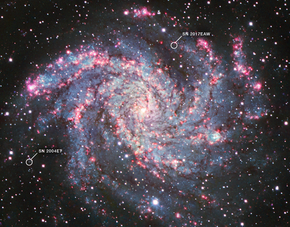SN 2004et is a bright type IIP[1] supernova that occurred in the spiral galaxy NGC 6946 (The Fireworks Galaxy[2]), about 22 million light years away from Earth.[3] The star that made the supernova was falsely identified to be a yellow supergiant but was then identified to be a type red supergiant of 13.8 solar masses. It was discovered alongside SN 2017eaw. SN 2004et showed some rebrightening about 1,000 days after the initial supernova probably due to ejecta of circumstellar material or thermal echo.[4][5] SN 2004et was one of the most luminous type IIP supernovae ever recorded and characterized.[6]
 | |
| Event type | Supernova |
|---|---|
| Type 2P | |
| Date | c. 22 million years ago (discovered 2004) |
| Instrument | Spitzer Space Telescope |
| Constellation | Cygnus |
| Right ascension | 20:35:25.330 |
| Declination | +60:07:17.6 |
| Epoch | J2000.0 |
| Distance | c. 22 million ly |
| Host | Fireworks Galaxy |
| Progenitor | Red supergiant c. 13.8 solar masses |
| Peak apparent magnitude | 20.89 |
| Other designations | SN 2004et |
| | |
Discovery
editSN 200et was discovered in 2004 and observed until 2009 by using the Spitzer InfarRed Array Camera,[7] a ultra sensitive infrared space telescope that is used to study planets, stars, asteroids, comets, and galaxies.[8]
References
edit- ^ Misra, Kuntal; Pooley, Dave; Chandra, Poonam; Bhattacharya, D.; Ray, Alak K.; Sagar, Ram; Lewin, Walter H. G. (October 2007). "Type IIP Supernova SN 2004et: A Multi-Wavelength Study in X-Ray, Optical and Radio". Monthly Notices of the Royal Astronomical Society. 381 (1): 280–292. arXiv:0707.3485. Bibcode:2007MNRAS.381..280M. doi:10.1111/j.1365-2966.2007.12258.x. ISSN 0035-8711. S2CID 14486373.
- ^ "NGC 6946: The 'Fireworks Galaxy' – NASA". Retrieved October 28, 2023.
- ^ information@eso.org. "Dusty supernovae (MIRI)". www.esawebb.org. Retrieved October 28, 2023.
- ^ "JWST observations of dust reservoirs in type IIP supernovae 2004et and 2017eaw". Retrieved October 28, 2023.
- ^ "SN 2004et | Transient Name Server". www.wis-tns.org. Retrieved October 28, 2023.
- ^ Maguire, K.; Di Carlo, E.; Smartt, S. J.; Pastorello, A.; Tsvetkov, D. Yu.; Benetti, S.; Spiro, S.; Arkharov, A. A.; Beccari, G.; Botticella, M. T.; Cappellaro, E.; Cristallo, S.; Dolci, M.; Elias-Rosa, N.; Fiaschi, M. (May 4, 2010). "Optical and near-infrared coverage of SN 2004et: physical parameters and comparison with other Type IIP supernovae: Optical and NIR coverage of SN 2004et". Monthly Notices of the Royal Astronomical Society. 404 (2): 981–1004. arXiv:0912.3111. doi:10.1111/j.1365-2966.2010.16332.x.
- ^ Shahbandeh, Melissa; Sarangi, Arkaprabha; Temim, Tea; Szalai, Tamás; Fox, Ori D; Tinyanont, Samaporn; Dwek, Eli; Dessart, Luc; Filippenko, Alexei V; Brink, Thomas G; Foley, Ryan J; Jencson, Jacob; Pierel, Justin; Zsíros, Szanna; Rest, Armin (June 22, 2023). "JWST observations of dust reservoirs in type IIP supernovae 2004et and 2017eaw". Monthly Notices of the Royal Astronomical Society. 523 (4): 6048–6060. arXiv:2301.10778. doi:10.1093/mnras/stad1681. ISSN 0035-8711.
- ^ "Spitzer Space Telescope – NASA Science". science.nasa.gov. Retrieved October 28, 2023.